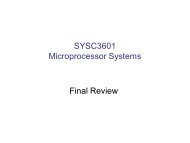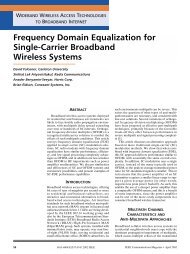Image Reconstruction for 3D Lung Imaging - Department of Systems ...
Image Reconstruction for 3D Lung Imaging - Department of Systems ...
Image Reconstruction for 3D Lung Imaging - Department of Systems ...
You also want an ePaper? Increase the reach of your titles
YUMPU automatically turns print PDFs into web optimized ePapers that Google loves.
<strong>for</strong> use with 2D reconstruction algorithms based on data from electrodes placed in a planar<br />
section <strong>of</strong> the medium as shown in figure 5.1(a). Adjacent current stimulation is used<br />
with adjacent voltage measurement at all remaining electrodes except the driven electrode<br />
pair. The general <strong>for</strong>mula <strong>for</strong> the number <strong>of</strong> measurements, M, obtained using this type <strong>of</strong><br />
injection-measurement protocol is M = (Nel −3)/Nel where Nel is the number <strong>of</strong> electrodes.<br />
For 16 electrodes, 208 measurements are available per frame, while <strong>for</strong> a 32 electrode system<br />
the number <strong>of</strong> available measurements is 928. Although the 16 injection-measurement<br />
patterns are obtained over a finite time interval, 80ms <strong>for</strong> the Goe-MF II, the entire vector<br />
<strong>of</strong> 208 measurements is treated as representing the boundary voltages at a single instant in<br />
time and is considered a frame <strong>of</strong> data.<br />
Data obtained from a 2D electrode placement such as in figure 5.1(a) is most <strong>of</strong>ten<br />
used to calculate a 2D estimate <strong>of</strong> the conductivity although a <strong>3D</strong> reconstruction algorithm<br />
could use these data. By placing the electrodes in multiple planes 2D equipment can be<br />
used to acquire data that are better suited <strong>for</strong> <strong>3D</strong> reconstructions. One such method is<br />
the hybrid electrode placement strategy (described in chapter 6) shown in figure 5.1(b) in<br />
which electrodes are placed in two axially aligned planes with the 16 electrodes connected<br />
sequentially as shown by the numbers in the figure. This arrangement will result in an<br />
inter-plane injection-measurements between electrodes 8 and 9 as well as 16 and 1. This<br />
strategy is used in this work in order to validate some <strong>of</strong> the simulated results with lab data<br />
collected using the Goe-MF II. The choice <strong>of</strong> 2 electrode planes was mainly one <strong>of</strong> simplicity<br />
and convenience. Many other electrode placement strategies are possible. The EIDORS v3<br />
suite [8], using the Complete Electrode Model, was extended to per<strong>for</strong>m the work in this<br />
paper.<br />
V13<br />
V12<br />
V11<br />
V14<br />
V10<br />
V15<br />
V16 is discarded<br />
Current Injection<br />
V9<br />
V8<br />
V2 is discarded<br />
(a) 2D adjacent drive protocol showing<br />
current injection between electrodes 1<br />
and 2 with and 13 individual measurements<br />
being made betwene the remaining<br />
electrodes.<br />
5.2.2 EIT Modeling<br />
V7<br />
V6<br />
V3<br />
V4<br />
V5<br />
E3<br />
E11<br />
E2<br />
E10<br />
E1<br />
E9<br />
(b) (b) Hybrid <strong>3D</strong> adjacent drive protocol.<br />
Finite Element mesh has 28 layers<br />
with a total or 21504 elements and 4205<br />
nodes. Electrodes are arranged in two<br />
layers <strong>of</strong> 8 electrodes.<br />
Figure 5.1: 2D and <strong>3D</strong> Finite Element meshes.<br />
We consider EIT difference imaging, which is widely understood to improve reconstructed<br />
image stability in the presence <strong>of</strong> problems such as unknown contact impedance, inaccurate<br />
electrode positions, non linearity, and the use <strong>of</strong> 2D approximations <strong>for</strong> <strong>3D</strong> electrical<br />
63





